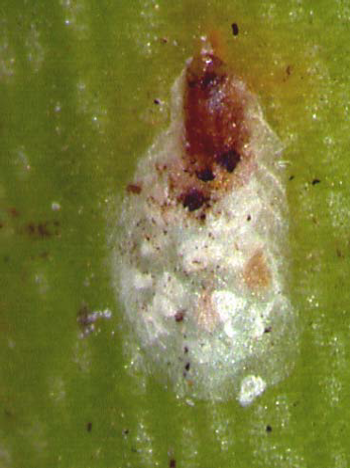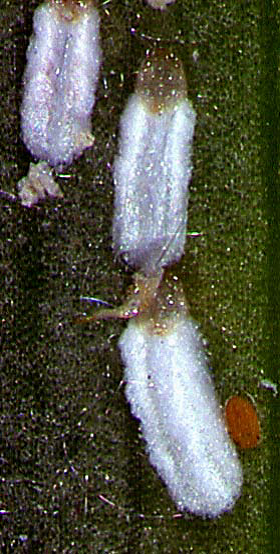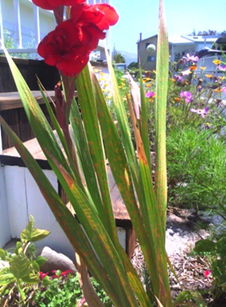Summer 2012 Field Observations
Watch out for invasive pests and diseases!
Lesser Snow Scale
One of the most important steps in avoiding invasive pests in the nursery is to isolate and carefully inspect all incoming shipments of plant material. All infested plant material should be treated or disposed of before introduction into the production area. One A-rated pest that is sometimes found in incoming shipments — especially in shipments from Hawaii and Florida — is the lesser snow scale (Pinnaspis strachani). This armored scale is extremely common in the southern and eastern areas of the United States. It is occasionally found in Southern California nurseries and was recently detected in a nursery in Ventura County.
Lesser snow scale (fig. 1) has a wide host range of over 150 plant hosts, including palms, foliage, hibiscus and orchids. It is a potential threat to agriculture because it is also a host of crops such as citrus and blueberries; it has been found on avocadoes coming into California from Mexico. The adult female is 2 to 3 mm long with a pear-shaped white cover. The immature male scale cover is white and elongated with three longitudinal ridges.
 |
 |
Fig. 1. Lesser snow scale, adult female (left) immature males (right). Photo courtesy of Natalia von Ellenrieder, California Department of Food and Agriculture.
Light Brown Apple Moth (LBAM)
Two male moths were recently detected in a Santa Barbara County nursery in Goleta inside the Santa Barbara County quarantine area. There is also a quarantine area in Santa Maria where three male moths were found earlier this year near production nurseries. Previously, detection of LBAM in Santa Barbara County nurseries was limited to Carpinteria.
Q-Rated Pathogens
Impatiens downy mildew (Plasmopara obducens) and basil downy mildew (Peronospora belbahrii) have been detected in multiple production nurseries in Santa Barbara County, according to Heather Scheck, Plant Pathologist for the Santa Barbara Agricultural Commissioner’s Office. Basil downy mildew was also found in Ventura County. Both are Q rated (quarantine significance). Details about these diseases are provided in Dr. Deborah Mathew’s feature article on mildews.
Heather Scheck also reports the first finding in a Santa Barbara County landscape of gladiolus rust (fig. 2). This Q-rated pathogen was recently detected in Carpinteria near a nursery that grows gladiolus. A survey of the area is planned.

Fig. 2. Gladiolus rust, Uromyces transversalis, was recently found in a Carpinteria garden. Photo by Heather Scheck, Santa Barbara County Agricultural Commissioner.
Julie P Newman
Floriculture and Nursery Crops Advisor
UC Cooperative Extension Ventura County
669 County Square Drive, #100
Ventura, CA 93003-5401
(805) 645-1459 phone, (805) 645-1474 fax
jpnewman@ucdavis.edu












